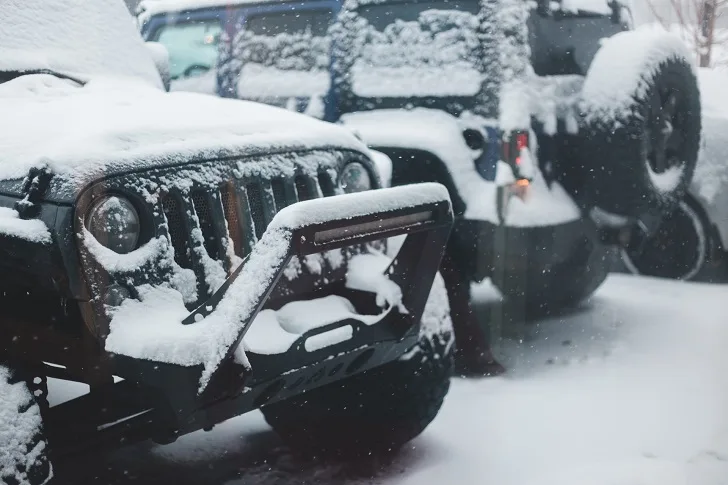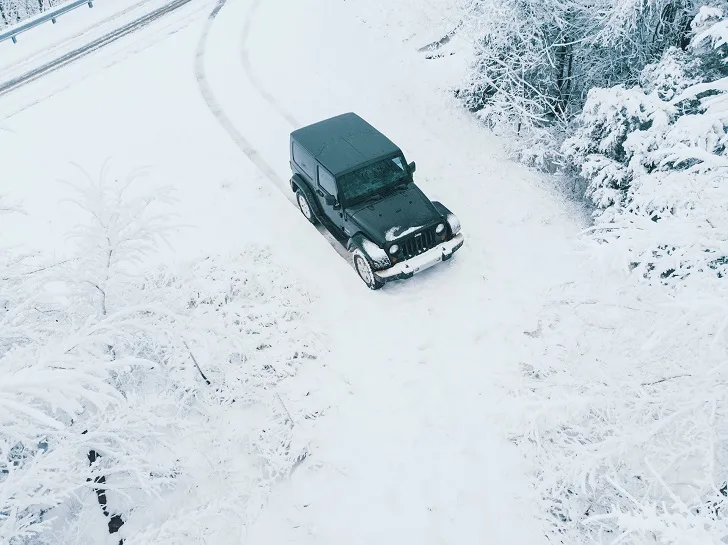Whether you love snow-related adventures or can’t avoid driving during the winter season or when it’s snowing, you’re surely wondering: “Are Jeep Wranglers good in snow?” The vehicle you drive during these times of the year will not only ensure your safety. It also helps you avoid expensive damages and repairs to your mode of transportation.
So, are Jeep Wranglers good in snow or during winter? Yes, they are. The vehicle’s off-road capabilities allow it to perform well in challenging terrain and during harsh winter conditions, from low to heavy snow and ice storms.
While some of you are itching to start searching for a Jeep Wrangler, second-hand or brand-new, don’t make any harsh decisions yet. Like buying any product, knowing what you’re getting your hands on is always best. Hence, allow me to share the Wrangler’s key features that make it suitable for snow (or winter) and how you can drive it more efficiently during the coldest months and one of the harshest seasons of the year.

How Good Is Jeep Wrangler in Winter or Snow?
We have already established that the Jeep Wrangler is a good option when driving in snow or during winter. But quantitatively, or giving it a specific number regarding how well it performs, can be subjective.
That said, here’s a quick overview of the Wrangler’s features that make it one of the best choices for snow (or winter) driving:
Robust Construction and Design
When you inspect the Jeep Wrangler’s specs and features, you’ll find that it screams an all-terrain and all-climate construction and design.
It has a sturdy suspension and frame and a 4WD (four-wheel drive) system, ensuring enhanced stability and traction even on icy and snowy terrains.
High Ground Clearance
Have you been living or lived in states with snowy winters like Maine, New York, and Alaska? Then, you would surely agree with me that a vehicle with a high ground clearance is a worthy investment. It’s like having one of the most comfortable, durable, non-slip snow boots (view on Amazon) that keep your feet warm and safe day and night during winter.
Why, you may ask? That’s because the vehicle is positioned way higher than the snow. Thus, you will have a clearer view of the road you’re traversing.
Also, it can, in a way, clear some of the snow, allowing you to drive safely and more conveniently through deeper snow. It also assures half of your car or whole vehicle won’t be covered with snow when you park it outside.
Thankfully, the Jeep Wrangler has a ground clearance ranging from 8.3 to 9.7 inches.
Well-Thought-Off Differential Design
Another great feature that makes the Jeep Wrangler good for snow or the winter season is its locking differential design. There are two different types, depending on your specific Wrangler model.
The standard, open design allows the Jeep’s wheel with limited or poor grip to spin perpetually, transferring some of the power to the wheel with a better grip. Doing so can prevent poor traction that can otherwise lead to slips and glides.
Meanwhile, the locking differential will allow each wheel to move at two different speed levels. This mechanism helps you, the driver, claw your way out or plow through a complicated situation, such as deep snow.
How Do You Drive a Jeep Wrangler in Snow or Winter?

While the features mentioned above make the Wrangler ideal for snow and winter driving, you also need to do your part for it to perform efficiently. As such, here are seven of the best (and practical) winter driving tips I can share with you:
Winter Driving Tip 1: Listen To The Latest Weather Forecast
The number one tip I could give you when driving your Wrangler, or any vehicle, during winter is to make sure you listen to the latest weather forecast. Doing so ensures you have a clear idea of the specific situation to expect, especially the kind of snow.
Is the snow fluffy? Wet? How deep is snow coverage outside or in specific areas? These pieces of information will help you plan how to drive your vehicle.
For instance, when driving on a paved road, you must avoid sudden shifts and car movements, such as curving. That’s especially true when the road is glazed with ice before being covered with shallow or deep snow.
Remember that driving too slowly can sink your car deep into the snow. Meanwhile, too high of a speed can freeze the snow on your tires. The frozen snow can negatively affect the tires’ performance, as they will lose grip or traction.
For snow-covered off-road terrains, make sure you accelerate as smoothly as possible. Doing so will help prevent your Wrangler from digging down into the snow.
Winter Driving Tip 2: Install Winter Tires
Yes, the factory-installed tires on your Wrangler will perform well in the snow or during winter, and they’ll receive support from the car’s other features. However, nothing beats the traction winter tires provide.
Winter tires, like the NEXEN Winguard Winspike 3 (view on Amazon), have unique tread patterns and compounds. These features ensure the tires maintain grip, even on ice, deep snow, and sub-freezing temperatures.
Winter Driving Tip 3: Switch To 4WD Mode and/or Locking Differential
Your Wrangler’s most significant asset when it comes to snow driving is its 4WD mode. Remember that its initial driving mode is RWD (rear-wheel drive). That’s why it’s critical for you to know how to turn on or switch to the 4WD mode.
Driving in 4WD mode ensures your Wrangler’s wheels head in the direction where you’re turning your steering wheel. This, in turn, will prevent your vehicle from spinning, especially on ice-laden roads.
Now, if you have a Wrangler without a 4WD Auto (automatic) setting, it’s also vital for you to familiarize yourself with the low-range and high-range settings. The high-range 4WD setting is ideal for low-traction driving situations, such as during snowy and icy conditions.
If you have a Wrangler with a switchable differential feature, ensure you know where the lever or switch is. You would need to switch from the standard to the locking differential mode when there’s too much snow or ice on the road.
Winter Driving Tip 4: Don’t Hit the Brake Too Hard
Slow and gentle braking is one of the keys to safe snow (or ice) driving, especially on paved roads. Remember, the road is slippery, so when you hit the brake too hard, you will most likely lose control of your Wrangler.
You must also avoid slamming your brake when off-road driving and you accidentally hit something like ice. It’s safer and more efficient to pump on it instead.
Winter Driving Tip 5: Keep Your Distance
Like riding a dirt bike in the rain, you must give your Wrangler a further distance from the vehicle or obstacle in front than you would normally do. It will give you enough time to hit the brake slowly or gently to prevent hitting whatever is in front of you and your car from spinning or sliding.
Winter Driving Tip 6: Drive Slowly
About the last two tips I shared, driving at a much slower speed is another safety tip when driving in extreme weather conditions. In fact, the 4WD mode won’t help you control your Wrangler (or any similar car) as much as you would expect when you drive it at a very high speed.
Why is this so? Your Jeep Wrangler has a high center of gravity mostly because of its heavy top and short wheelbase. Thus, it might roll or tip over once you make a sharp turn. It’s why you must also reduce your speed, even when you’re already driving slowly, when taking a curve.
Driving slowly will also ensure you can pay more attention to the road signs, vehicles, and obstacles around you. And as I have mentioned, to give you enough time and distance to hit the brake slowly.
Winter Driving Tip 7: Consider Purchasing Car Accessories for Snow
You’re all dressed up for the winter season, so why not accessorize your Jeep Wrangler, too?
While it isn’t necessary, installing a set of rear or front tire chains will make driving on snow much easier and safer. They’re designed to plow snow, ensuring enhanced and safer car maneuvering.
Yes, your Wrangler’s huge wheels and tires can already do some of the plowing, but a little help from the chains won’t hurt. That is especially true when driving on endless, unplowed, deep snow.
I suggest replacing your standard Jeep Wrangler’s floor mats with durable, easy-to-clean, all-weather floor mats or liners (view on Amazon). Although they won’t improve your vehicle’s performance when driving in snow, they’ll protect your carpet from salt (used to de-ice roads), water (melted ice or snow), grime, and mud more efficiently.
And yes, you don’t have to remove them when the winter season is over! They’re perfect for all types of dirt and debris.
Are Jeep Wranglers Good in Snow: In Conclusion
The robust Jeep Wrangler and its excellent off-road features make it one of the top choices for snow driving. Just make sure you read its owner’s manual to the T and get to know each feature by heart.
What are the levers, buttons, etc.? What are their uses? When should you use them? This knowledge ensures you maximize the capabilities of your Jeep Wrangler. That is whether you’re driving on snowy or icy roads, during the rainy season, on a regular day, or simply enjoying your summer off-road adventures!
And, of course, don’t forget to drive more patiently to avoid speeding and hitting the brakes too hard.
References:
- reddit.com
- wranglerforum.com
- jlwranglerforums.com (Snow and ice performance)
- jlwranglerforums.com (Jeep snow performance, need advice)
- reddit.com
Kris is an avid off-roader and outdoor enthusiast who loves to brave the elements and take on challenging terrain. He also enjoys sharing his passion and knowledge with others so that they, too, can appreciate the ride.
About Kris
